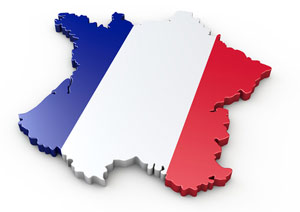
How do I invest in the CAC 40?
Stock trading is the most common method of investing in the CAC 40. Investors buy stocks from companies listed in the index in the hope that their price will rise, allowing them to make a profit by selling them at a higher price. In addition, investors may receive dividends from the companies in which they have invested, which is an added benefit.
Buying and selling CAC 40 stocks:
Trading stocks on the CAC 40 involves the direct buying and selling of stocks from companies included in the index. Investors can select specific companies based on their fundamental and technical analysis, then buy stocks in the hope that their value will rise.
In addition to potential capital gains, investors can also receive regular dividends from the companies in which they have invested, an added benefit of this longer-term investment method.
Investing in CAC 40 futures:
Trading CAC 40 futures allows traders to buy or sell contracts at a future date at a pre-determined price. These contracts are based on the index itself, which means that traders do not actually own stocks in the individual companies.
This method is often used for short-term trading, with transactions taking place over a period of a few days or weeks. Futures offer traders the opportunity to profit from directional movements in the index without having to buy or sell individual stocks.
Trading the CAC 40 with CFDs:
Contracts for Difference (CFDs) allow traders to speculate on the rise or fall of the CAC 40 index without actually owning the underlying assets. CFDs offer significant flexibility, allowing traders to take long or short positions in the index according to their market expectations.
This method is often used in the short term to take advantage of daily price fluctuations. CFDs can be traded on a leveraged basis, which means that traders can potentially make larger gains, but this also entails an increased risk of loss.
Trade now on the CAC 40!{etoroCFDrisk}% of retail CFD accounts lose money - etoro.com
Trading the CAC 40 with ETFs:
Exchange Traded Funds (ETFs) are exchange-traded funds that track the performance of an index or basket of stocks. CAC 40 ETFs allow investors to invest in a diversified portfolio of CAC 40 stocks with a single holding. This provides instant exposure to the entire index, which is suitable for investors seeking a more passive or diversified approach.
ETFs can be traded like ordinary stocks on stock exchanges, offering high liquidity and generally low fees. This method is often preferred by long-term investors looking to replicate the overall performance of the CAC 40.
What do I need to know before trading in the CAC 40 French stock market index?
Let us initially examine the major factors of the CAC 40 Index that you should know to be able to analyse this index correctly.
The CAC 40 is a French stock market Index which, as its name suggests, is composed of the top 40 French companies quoted on the Paris Euronext stock market. This index is therefore part of one of the leaders of the European financial marketplaces, Euronext, and alone represents over 80% of the French financial markets.
The companies of which the CAC 40 stock market index is composed are selected from among the top 100 French companies from different activity sectors that represent as objectively as possible the state and the health of the French economy.
From a historical point of view, we would note that the CAC 40 stock market index was created on the 31 December 1987 when its initial quote was for 1,000 points. It was the ‘Compagnie des Agents de Change’, hence the initials CAC, that created this index following the crash of 1987. However since then things have changed. The initials now represent the name ‘Cotation Assistée en Continu’ simply because the rate for this index is updated every 15 seconds during the opening hours from Monday to Friday, 9 a.m. to 5.30 p.m.
Of course, the list of companies represented on the CAC 40 Index changes over time, as with other international stock market indices. Certain companies exit this index and others with a higher stock market capital take their place.
However, certain particularly solid companies have been included in the CAC 40 since it was first created. These are as follows: Accor, Air Liquide, Carrefour, Danone, Lafarge-Holcim, l’Oreal, LVMH, Michelin, Saint Gobain, Sanofi, Société Générale and Vivendi. It should also be noted that since its creation 32 years ago, 94 French companies have at one time or another been included in this index.
How is the CAC 40 stock market index rate calculated?
Understanding the operation of the CAC 40 and its composition is clearly very important but it is also necessary to know how its rate is calculated. This is what we shall now explain.
To understand this method of calculation, it should first be remembered that in December 2003 the CAC 40 adopted a floating stock market capital calculation method that takes into account the number of shares available for purchase on the market by the quoted company. This modified method of calculation aims to be close to that used already for the major international stock market indices.
To summarise, the calculation of the CAC 40 rate is based on the stock market capital of the companies of which it is composed and it is obtained through the multiplication of the number of shares of each company on the market by the price of the shares.
Concerning the management of the CAC 40 index, notably the updates of the assets of which it is composed, it is the scientific Board of the Euronext stock market indices, composed of a number of independent experts of these stock market indices, that is responsible for these revisions and decides therefore which companies enter or exit this index with the aim of providing a fair representation. This board of eight independent experts from universities, industry and analysts meet every three months, on the third Friday in March, June, September, and December. When making their decisions they take into account the transaction volume of the company’s shares, the representation in the activity sectors on a national level, and the fluidity and regular trading of the assets.
Trade now on the CAC 40!{etoroCFDrisk}% of retail CFD accounts lose money - etoro.com
Historical evolution of the CAC 40 :
- 1988: This is the year the CAC 40 index was created. In reality, this index was launched on 31 December 1987 following the adoption of the 1984 banking law and in the context of the rise of financial globalisation and after the 1987 crash.
- 2000: That year, the CAC 40 reached an all-time high of 6,944.77 points thanks to the speculative bubble in telecom, media and technology stocks. It then fell with the bursting of this bubble to 2,401.15 points in March 2003.
- 2003: Since 2003, the CAC 40 takes into account the free float in addition to the market capitalisation of the companies that make it up.
- 2008: That year, the CAC 40 fell again, dropping below 4,200 points in July and 3,200 points in October. This was a real stock market crisis. Over the year as a whole, the index experienced the sharpest fall in its history with -42.68%.
- 2011: 2011 was the year of another crash for the CAC 40 index which fell by 28.8% between July and September.
- 2017 : The CAC 40 begins to include new technology stocks such as Atos, STMicroelectronics, Dassault Systèmes and Thales.
- 2019: This year will be marked by a record dividend distribution of more than €49.2 billion and share buybacks of more than €10.7 billion.
- 2020 : With the Covid-19 pandemic, the CAC 40 will record the biggest drop in its history in 2020 with a fall of 12.28% on 12 March. After starting the year at over 6,000 points, it was down to 4,044.26 points at the end of that session. The fall continued towards 3 754.84 points on 18 March, i.e. a total loss of more than 40% of its value in one month. Before the end of the year, however, the index will rebound rapidly with a 20% gain before the end of March and a second 20% rise in November after the announcement of the effectiveness of the first vaccines.
- 2021: At the beginning of 2021, the CAC 40 exceeds its pre-pandemic peak, buoyed by hopes of a recovery, and reaches 6,131.34 points, close to its 2007 record level, thanks in particular to cyclical stocks. It will continue to rise and will approach the 6,800-point level in the summer of 2021. Finally, the psychological threshold of 7,000 points will be crossed in November 2021 and will mark an absolute historical high.
- 2022 : The upward trend of the CAC 40 index continues and a new all-time high is reached on 5 January 2022 at 7,376.37 points at the close and an all-time high at 7,384.86 points during the session. However, a downward correction driven by the war in Ukraine led to a further decline until the low of 5,962.96 points was reached in March 2022.
A technical analysis of the CAC 40 index rate and the indicators to follow:
The second analysis you should use to study the growth possibilities of the CAC 40 index is the technical analysis.
This is based uniquely on the study of this index’s charts and its current and historical rates. To complete a comprehensive technical analysis it is however important to have some understanding of the methodology and principal technical trend and volatility indicators as follows:
- The mobile averages
- The MACD indicator
- The Bollinger bands
- The pivot points
- The technical support and resistance levels
The more indicators you use the more pertinent and precise your analyses will be. Of course, for this you should pay careful attention to the charts you use for this analysis and in particular favour those that can be personalised to your requirements. These charts, available from online brokers, will actually enable you to generate different displays of curves, timelines and indicators for a clearer visibility. Then you simply have to interpret the movements that you observe on your monitor to obtain the required signals.
We would nonetheless draw your attention to the fact that this technical analysis should never be used alone, always with an accompanying comprehensive fundamental analysis, whatever the asset you are studying.


